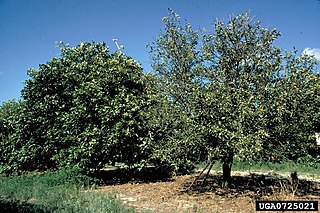Viroids are small single-stranded, circular RNAs that are infectious pathogens. Unlike viruses, they have no protein coating. All known viroids are inhabitants of angiosperms, and most cause diseases, whose respective economic importance to humans varies widely. A recent metatranscriptomics study suggests that the host diversity of viroids and other viroid-like elements is broader than previously thought and that it would not be limited to plants, encompassing even the prokaryotes.

Citrus greening disease or yellow dragon disease is a disease of citrus caused by a vector-transmitted pathogen. The causative agents are motile bacteria, Liberibacter spp. The disease is transmitted by the Asian citrus psyllid, Diaphorina citri, and the African citrus psyllid, Trioza erytreae, also known as the two-spotted citrus psyllid. It has no known cure. It has also been shown to be graft-transmissible.

Theodor Otto Diener was a Swiss-American plant pathologist. In 1971, he discovered that the causative agent of the potato spindle tuber disease is not a virus, but a novel agent, which consists solely of a short strand of single-stranded RNA without a protein capsid, eighty times smaller than the smallest viruses. He proposed to name it, and similar agents yet to be discovered, viroids. Viroids displaced viruses as the smallest known infectious agents.

A leaf spot is a limited, discoloured, diseased area of a leaf that is caused by fungal, bacterial or viral plant diseases, or by injuries from nematodes, insects, environmental factors, toxicity or herbicides. These discoloured spots or lesions often have a centre of necrosis. Symptoms can overlap across causal agents, however differing signs and symptoms of certain pathogens can lead to the diagnosis of the type of leaf spot disease. Prolonged wet and humid conditions promote leaf spot disease and most pathogens are spread by wind, splashing rain or irrigation that carry the disease to other leaves.
The potato spindle tuber viroid (PSTVd) was the first viroid to be identified. PSTVd is a small, single stranded circular RNA molecule closely related to the chrysanthemum stunt viroid. Present within the viroidal RNA is the Pospiviroid RY motif stem loop common to its genus. The natural hosts are potatoes and tomatoes. All potatoes and tomatoes are susceptible to PSTVd and there is no form of natural resistance. Natural infections have also been seen in avocados and infections in other solanaceous crops have been induced in the laboratory. Until 2017 PSTVd was thought to be unable to infect Solanum sisymbriifolium. Then in May seeds exported by a Dutch company were noticed to be infected. These seeds were shipped from the company, but had been originally bred to their specifications in two Asian countries. Pstv also causes Tomato bunchy top and is seed transmitted in tomato.
The Pospiviroidae are a incertae sedis family of ssRNA viroids with 5 genera and 39 species, including the first viroid to be discovered, PSTVd, which is part of genus Pospiviroid. Their secondary structure is key to their biological activity. The classification of this family is based on differences in the conserved central region sequence. Pospiviroidae replication occurs in an asymmetric fashion via host cell RNA polymerase, RNase, and RNA ligase. its hosts are plants, specifically dicotyledons and some monocotyledons

Citrus canker is a disease affecting Citrus species caused by the bacterium Xanthomonas. Infection causes lesions on the leaves, stems, and fruit of citrus trees, including lime, oranges, and grapefruit. While not harmful to humans, canker significantly affects the vitality of citrus trees, causing leaves and fruit to drop prematurely; a fruit infected with canker is safe to eat, but too unsightly to be sold. Citrus canker is mainly a leaf-spotting and rind-blemishing disease, but when conditions are highly favorable, it can cause defoliation, shoot dieback, and fruit drop.

Potato leafroll virus (PLRV) is a member of the genus Polerovirus and family Solemoviridae. The phloem limited positive sense RNA virus infects potatoes and other members of the family Solanaceae. PLRV was first described by Quanjer et al. in 1916. PLRV is transmitted by aphids, primarily the green peach aphid, Myzus persicae. PLRV is one of the most important potato viruses worldwide but particularly devastating in countries with limited resources and management. It can be responsible for individual plant yield losses of over 50%. One estimate suggests that PLRV is responsible for an annual global yield loss of 20 million tons. Symptoms include chlorosis, necrosis and leaf curling.
Citrus tristeza virus (CTV) is a viral species of the genus Closterovirus that causes the most economically damaging disease to its namesake plant genus, Citrus. The disease has led to the death of millions of Citrus trees all over the world and has rendered millions of others useless for production. Farmers in Brazil and other South American countries gave it the name "tristeza", meaning sadness in Portuguese and Spanish, referring to the devastation produced by the disease in the 1930s. The virus is transmitted most efficiently by the brown citrus aphid.

Alternaria alternata is a fungus causing leaf spots, rots, and blights on many plant parts, and other diseases. It is an opportunistic pathogen on over 380 host species of plant.
Alternaria citri is a fungal plant pathogen that causes black rot in citrus plants.
Cherry mottle leaf virus (CMLV) is a plant pathogenic virus causing leaf rot. It is closely related to the peach mosaic virus.

Prunus necrotic ringspot virus (PNRSV) is a plant pathogenic virus causing ring spot diseases affecting species of the genus Prunus, as well as other species such as rose and hops. PNRSV is found worldwide due to easy transmission through plant propagation methods and infected seed. The virus is in the family Bromoviridae and genus Ilarvirus. Synonyms of PNRSV include European plum line pattern virus, hop B virus, hop C virus, plum line pattern virus, sour cherry necrotic ringspot virus, and peach ringspot virus.

Citrus psorosis ophiovirus is a plant pathogenic virus infecting citrus plants worldwide. It is considered the most serious and detrimental virus pathogen of these trees.
The hop stunt viroid is a viroid species that infects the common hop plant, citrus plants, grapevines, cucumber, and several Prunus species such as almond, apricot, plum, and peach. It is asymptomatic or latent in most host plants, but in some hosts it can cause stunting and other symphtoms. A study of HSVd-infected hops in the USA showed that the severity of yield reduction was highly dependent on the infected hop cultivar.
Cadang-cadang is a disease caused by Coconut cadang-cadang viroid (CCCVd), a lethal viroid of several palms including coconut, African oil palm, anahaw, and buri. The name cadang-cadang comes from the word gadang-gadang that means dying in Bicol. It was originally reported on San Miguel Island in the Philippines in 1927/1928. "By 1962, all but 100 of 250,000 palms on this island had died from the disease," indicating an epidemic. Every year one million coconut palms are killed by CCCVd and over 30 million coconut palms have been killed since Cadang-cadang was discovered. CCCVd directly affects the production of copra, a raw material for coconut oil and animal feed. Total losses of about 30 million palms and annual yield losses of about 22,000 metric tons of copra have been attributed to Cadang-cadang disease in the Philippines.
The Citrus stubborn disease is a plant disease affecting species in the genus Citrus. Spiroplasma citri, a Mollicute bacterium species, is the causative agent of the disease. It is present in the phloem of the affected plant. Originally discovered transmitted by several leafhoppers including Circulifer tenellus and Scaphytopius nitridus in citrus-growing regions of California, it is now spread by the same hoppers in Arizona and Circulifer haematoceps in the Mediterranean region.
Pecan bacterial leaf scorch is a disease of the pecan tree that is common throughout the production regions of the United States caused by the pathogenic bacterium Xylella fastidiosa subsp. multiplex. The pathogen was initially discovered to be coincidentally associated with symptoms of pecan fungal leaf scorch in 1998 and has subsequently been found to be endemic in the southeastern United States, as well as Arizona, California, and New Mexico.

Citrus blight is a type of blight that occurs in tropical and semi-tropical regions. Specializing in infecting citrus trees, the blight is found in North America, the Caribbean, South America, South Africa and Australia. The blight injures plants by forming blockages in xylem and phloem, inhibiting resource distribution and resulting in plant die-back and smaller fruit yields. As of 2020 there is no cure for the blight, and neither the causal agent nor spreading mechanism is known.
Bunchy top most commonly refers to:








